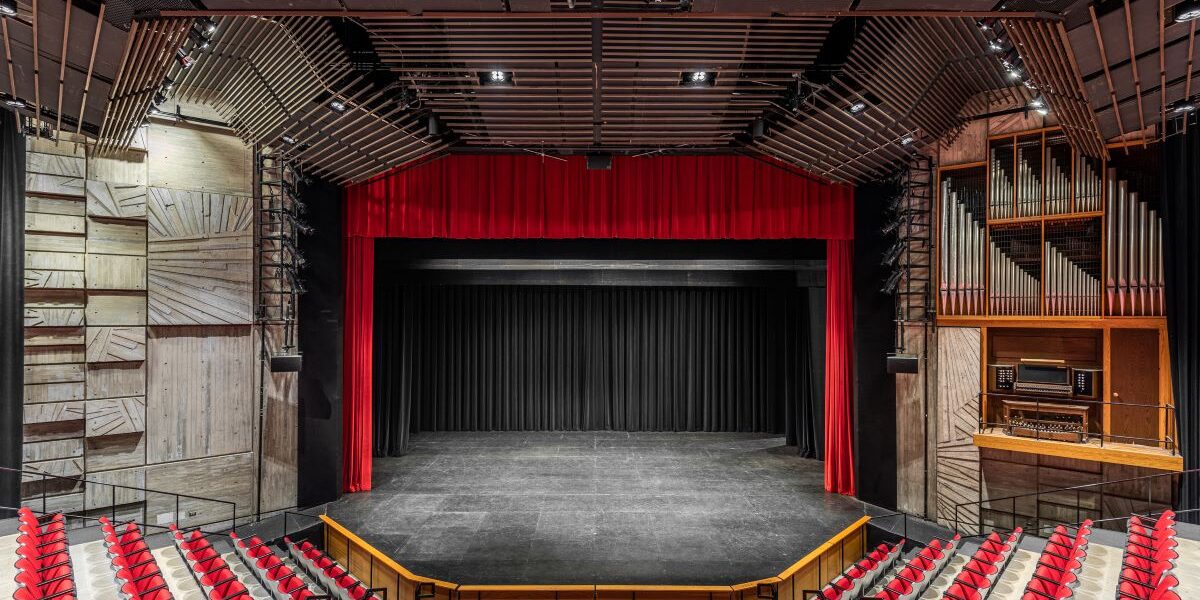Whether improving technical capabilities, increasing comfort, or creating more opportunities for creativity and learning, a few well-chosen upgrades can help transform your facility into a more versatile, professional and inspiring learning environment.
If you’re looking for ways to update and upgrade your venue, here are nine projects to help bring your theatre into the 21st century.
- Backstage Lighting
Dedicated run lights backstage ensure students can safely see in high-traffic and technical areas. Blue lights, in particular, are commonly used in theatres because they can be bright enough to see by but do not bleed or “leak” through curtains. These lights can even be controlled from the light board so you don’t have to run around the whole theatre before a show.
- Backstage Communication
Install a high-quality headset system. This will help make your performances run smoother, but if something goes wrong — an upset stomach due to stage fright, a broken prop, etc. — communication is key for your team handling whatever comes their way.
- Motorized Rigging
Rigging is how lighting, scenery, and drapes are hung over the stage and moved. Rigging can be dead hung (stays in place), manually operated or motorized (for moving curtains, backdrops, etc.). Dead-hung rigging requires students and teachers to climb ladders to access equipment.
Motorized rigging brings the equipment safely down to the stage to work. Motorized rigging also tends to be safer than manual systems because the rigging system controls the weight, not stagehands pulling ropes.
Note: Most architects have never worked on rigging systems before. You’ll need an experienced consultant who has designed rigging systems and understands your theatre. Anyone operating it should be trained, and your system will need annual safety inspections.
- Upgrade to LED Stage Lights
This can simplify your lighting layout and save the school money over time, as LED bulbs often require less energy than traditional incandescent lights and don’t burn out. They are also color-changing, so there’s no more gel to cut!
If your lighting board is older, upgrading it as well can provide you with better functionality and even more creative lighting design options for your productions.
- Digital Sound Console & Wireless Mic Systems
Upgrading an out-of-date sound board and investing in wireless mics for your theatre can make a huge difference in the quality of performances and the overall experience for students and audiences.
When students know their work will be presented with high-quality production value, it gives them a sense of pride and raises the standard of performances.
Wireless mics allow performers to move freely without being tied down by cables or standing in specific spots for stationary mics. Also, wireless mics reduce the risk of tripping over cables.
Students learning the technical side of theatre get hands-on experience with industry-standard equipment. They can learn sound design, live mixing, and mic management — skills that are super valuable if they pursue theatre or audio careers.
- Stage Projectors
A high-definition theatrical projector and the appropriate lens for the depth of your stage can integrate multimedia capabilities into your shows and reduce your need for painted backdrops or constructed scenery.
Theatrical projectors differ from traditional projectors and typically need higher brightness levels to overcome stage lighting. Regular projectors may offer 3,000-4,000 lumens, while theatrical setups might require projectors with 10,000 lumens or more
- Stage Flooring Upgrade
Equipment, set pieces, painting, and foot traffic wear down floors over time — and worn-out or uneven floors can cause slips, trips, and falls. A good stage floor helps minimize those risks. A stage floor should be resilient, like a gym floor to prevent injuries to dancers and actors.
Finish options include:
Masonite or hardboard: A standard surface for multipurpose stages, often painted or treated for different looks. The surface layer is meant to be easily replaceable.
Hardwood: Some schools prefer the look of a traditional hardwood floor. Wooden strip flooring can even be incorporated into a dedicated sprung floor system!
- New Seating
Old seats can be uncomfortable and noisy, leaving audiences distracted and dissatisfied. Upgrading seating with better padding, ergonomic design and quieter hardware can greatly enhance comfort and overall experience.
Additionally, new seating offers better accessibility, including designated spaces for wheelchair users, companion seating, and easier entry and exit for people with mobility challenges.
- Acoustic Treatments
Sound-absorbing materials — fabric panels, carpet, drapes and curtains — can reduce echoes and prevent sound from bouncing around, helping to improve audio clarity for amplified performances.
For unamplified concerts, acoustic shells or reflectors behind performers can help project sound into the audience without needing more amplification. Variable elements, like curtains and shells, can be used together to totally transform the sound quality of the same space to make it ideal for different types of music or speaking events.
How to Prioritize an Upgrade
When budgets and time are tight (when aren’t they?), it’s important to prioritize where to focus. Safety is always top of the list, but after that, ask yourself what project you can realistically complete that will make the most impact on your students. Then, consider what every parent wants in a school show: to see and hear their child.
A well-equipped, modernized theatre not only enhances the quality of performances but also fosters a safer, more creative learning environment for students. By making thoughtful upgrades, you invest in the future of your program and inspire the next generation of performers, technicians, and creative minds.
Alec Stoll, ASTC, is a partner at Stages Consultants, which offers expert theatre planning, acoustics consulting, and equipment specification for a wide range of performance spaces, www.stagesconsultants.com. He is internationally respected as a theatre planner and designer and has worked as a theatre consultant for nearly 25 years.





